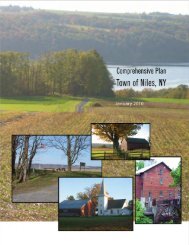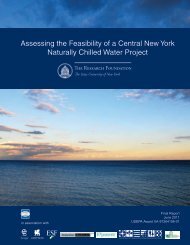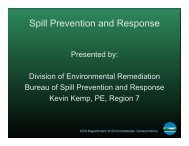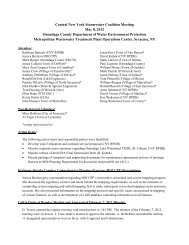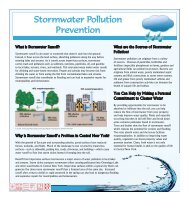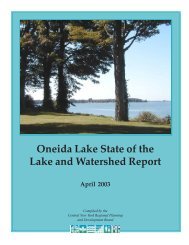A Management Strategy for Oneida Lake and its ... - CNY RPDB Home
A Management Strategy for Oneida Lake and its ... - CNY RPDB Home
A Management Strategy for Oneida Lake and its ... - CNY RPDB Home
You also want an ePaper? Increase the reach of your titles
YUMPU automatically turns print PDFs into web optimized ePapers that Google loves.
page 22<br />
Water Supply Systems<br />
Residents of the <strong>Oneida</strong> <strong>Lake</strong> watershed<br />
receive drinking water from either municipal<br />
or private surface water or groundwater<br />
supplies from within as well as outside of<br />
the watershed. In addition to providing<br />
water to communities within the watershed,<br />
<strong>Oneida</strong> <strong>Lake</strong> tributaries are also used to<br />
provide water <strong>for</strong> communities beyond the<br />
watershed boundary. Under ordinary<br />
conditions, these supplies are ample <strong>for</strong><br />
agriculture, industrial, <strong>and</strong> domestic use.<br />
However on occasion, such as the summer<br />
of 1999, drought conditions reduce surface<br />
water <strong>and</strong> groundwater supplies to the<br />
region.<br />
The availability of a clean <strong>and</strong> dependable<br />
water supply is essential <strong>for</strong> human health<br />
<strong>and</strong> the economic survival of the <strong>Oneida</strong><br />
<strong>Lake</strong> region. As water travels over the<br />
surface of the l<strong>and</strong> or through the ground, it<br />
dissolves naturally occurring minerals <strong>and</strong><br />
can pick up pollutants resulting from the<br />
presence of animals or from human activity.<br />
These contaminants can result in waterborne<br />
diseases that afflict humans as well as the<br />
ecosystem. Fortunately, water hardness <strong>and</strong><br />
the presence of salt in the deeper bedrock<br />
wells are the primary naturally occurring<br />
water quality nuisances facing users in the<br />
watershed. Naturally occurring sulfur is<br />
also a common nuisance found in wells<br />
throughout the <strong>Oneida</strong> <strong>Lake</strong> watershed.<br />
Contaminants such as E. coli <strong>and</strong> nitrates,<br />
<strong>and</strong> disease-causing organisms such as<br />
Cryptosporidium parvum <strong>and</strong> Giardia<br />
lamblia, come from human <strong>and</strong> animal<br />
wastes. In the <strong>Oneida</strong> <strong>Lake</strong> watershed,<br />
failing septic systems <strong>and</strong> agricultural runoff<br />
are two potential sources of these contaminants.<br />
In addition to microbial contaminants,<br />
fertilizers, pesticides, <strong>and</strong> other<br />
chemicals applied to the l<strong>and</strong> may enter<br />
groundwater or runoff into surface water.<br />
All of these contaminants are harmful to<br />
human health at certain levels, <strong>and</strong> water<br />
containing them is considered unsuitable <strong>for</strong><br />
human consumption if the pollutants exceed<br />
established lim<strong>its</strong>.<br />
Wastewater Treatment<br />
The collection <strong>and</strong> treatment of wastewater is<br />
important to safeguard public health, protect<br />
water quality, <strong>and</strong> ensure the overall survival of<br />
a region. In the <strong>Oneida</strong> <strong>Lake</strong> watershed, sewage<br />
<strong>and</strong> septic systems have increased in number<br />
<strong>and</strong> capacity due to urbanization, development,<br />
<strong>and</strong> increased population. There are 17 municipal<br />
wastewater treatment plants serving communities<br />
in the watershed. Two treatment plants<br />
discharge directly into <strong>Oneida</strong> <strong>Lake</strong>, <strong>and</strong> 12<br />
discharge to tributaries of the lake. The remaining<br />
three serve municipalities within the watershed,<br />
but discharge their treated wastewater to<br />
waterbodies outside the watershed. The treatment<br />
of municipal wastewater is highly regulated<br />
by the state <strong>and</strong> federal governments<br />
through wastewater discharge perm<strong>its</strong>.<br />
In rural <strong>and</strong> sparsely populated suburban areas it<br />
may not be economically feasible to construct<br />
community wastewater treatment facilities. In<br />
these areas, on-site septic systems are traditionally<br />
used to dispose of wastewater. Overall,<br />
properly sited <strong>and</strong> maintained individual on-site<br />
wastewater treatment systems can treat wastewater<br />
effectively <strong>and</strong> not threaten water quality.<br />
However, poor site conditions, improper system<br />
installation <strong>and</strong> maintenance, as well as overloading<br />
can drastically decrease the life of the<br />
system <strong>and</strong> pose a significant threat to water<br />
resources.<br />
Flooding<br />
Flooding occurs in the region surrounding<br />
<strong>Oneida</strong> <strong>Lake</strong>, often after major storm events or<br />
rapid winter thaws. No organization has the<br />
authority or responsibility <strong>for</strong> controlling<br />
<strong>Oneida</strong> <strong>Lake</strong> water levels to prevent flooding or<br />
to reduce the frequency <strong>and</strong> duration of flooding.<br />
The New York State Canal Corporation<br />
Chapter 2: <strong>Oneida</strong> <strong>Lake</strong> <strong>and</strong> Its Watershed



